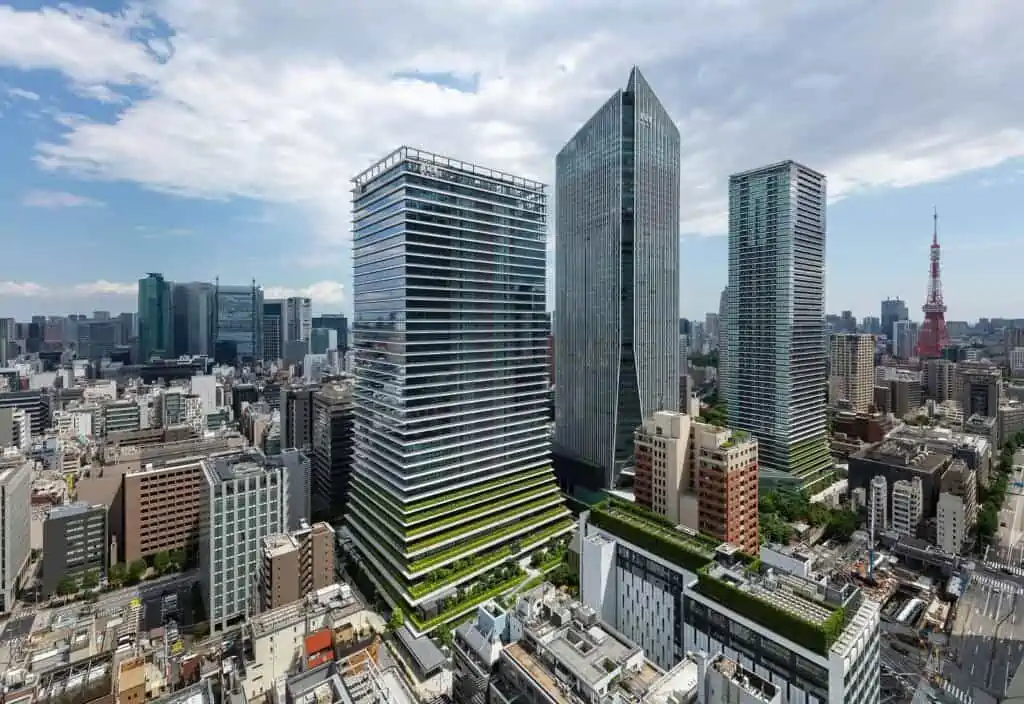Tokyo’s new pair of green skyscrapers shows how to live in harmony with nature.
Ever dreamt of living in a lush garden, but also benefiting from the advantages of a high-tech modern home? Well, I’ve got some good news. Two unique green skyscrapers were completed in Tokyo, Japan — and they might be just what you’re looking for. Covered in trees and other plants, with a green cover spread from the ground floor all the way up to the 11th and 7th floors of the two buildings, respectively, these modern buildings are a sight to behold.
From the outside, it almost looks like both the skyscrapers have a forest within them — and that’s exactly what the architects were going for. The newly constructed buildings are called the Toranomon Residential Tower and Toranomon Business Tower. They are parts of the Toranomon project that also includes the third tallest building in Tokyo.
The height of the business tower is 607 feet (185 meters) and that of the residential tower is 722 feet (220 meters), the latter now also stands as the tallest residential building in Japan, per New Atlas. Both towers were constructed by Ingenhoven Architects, a firm based in Germany.
The Toranomon towers are shiny symbols of biophilia
Most if not all humans like to feel a connection with nature and other living organisms and — a theory called biophilia. It might be the reason why most of us feel both calm and relaxed in a place that has more natural air and is surrounded by lots of trees and flowery plants.
The new Toranomon towers took that idea to heart, and they themselves can be considered a symbol of biophilia as their design gives humans the opportunity to stay close to nature while being in a highly urbanized area.
The architects at Ingenhoven often refer to the structure as their “vertical garden city”. Eleven out of the total 54 floors in the residential buildings and seven out of 36 floors in the business tower are surrounded by lush green vegetation. The taller one has 550 housing units and both skyscrapers have been designed to withstand earthquakes.
Since Tokyo is ranked among the most earthquake-prone cities in the world, the architects have installed dampers in both buildings and established connections with a nearby temple building to minimize the effect of any seismic activity. The residential and business towers represent a perfect combination of green and modern living.
While the buildings have more than enough room for vegetation to thrive in and around the space, these urban marvels also have spas, gyms, and various other modern amenities that make human life more comfortable.
The architects believe that the modernism of the new skyscrapers compliments the existing Toranomon Hills Tower, whereas its green elements pay tribute to the Atago Shrine, a historical site located at a distance of just 19 km (11.8 miles) from the towers. The shrine was originally built in 1603 and is surrounded by a serene garden.
Good for the air as well
Any building ranging from a small house to a tall skyscraper that humans inhabit is a regular source of carbon emissions. The different activities (cooking, washing) and equipment (air conditioner, refrigerator) inside a building have their own carbon footprint but what if these emissions get canceled out? Since trees suck in CO2 via photosynthesis, planting trees on, inside, and around a building is the easiest and most effective way to make it carbon neutral.
In urban settings such as crowded cities and special economic zones where limited space is available for planting trees. There is no better way to reduce carbon footprint and clean up the polluted air other than by constructing buildings as vertical gardens. Green skyscrapers offer great opportunities for us to live in harmony with nature and provide us with benefits worth millions of dollars.
For instance, the Santalaia residential building in Columbia which also happens to be the biggest vertical garden in the world produces oxygen for over 3000 people, clears pollution generated by 745 vehicles, and cancels the carbon footprint of 700 individuals every year. Similarly, the Tree House building in Singapore saves the management about $500,000 on water and power bills.
The construction of Toranomon towers is another big step in the direction of making green skyscrapers mainstream phenomena. Hopefully, it would encourage thousands of people to experience and promote the benefits and values that come with adopting sustainable living.

































